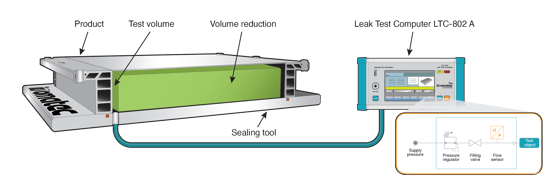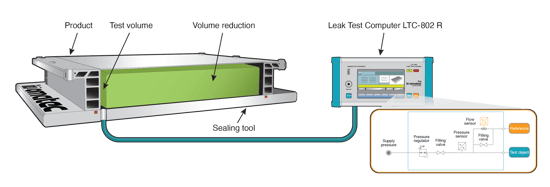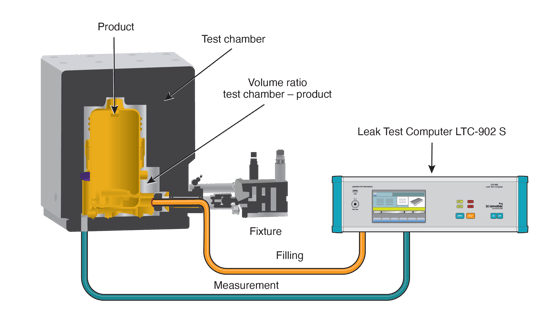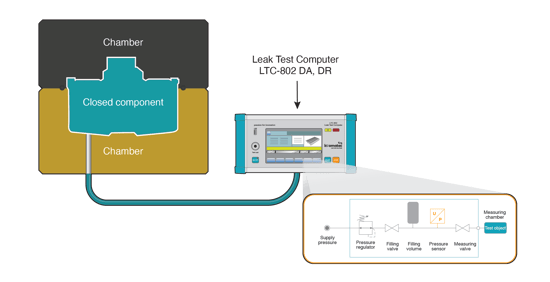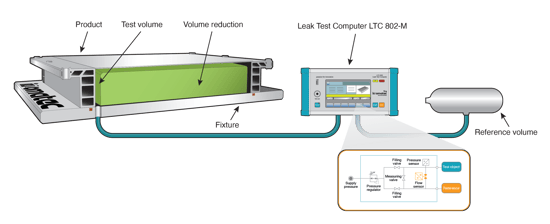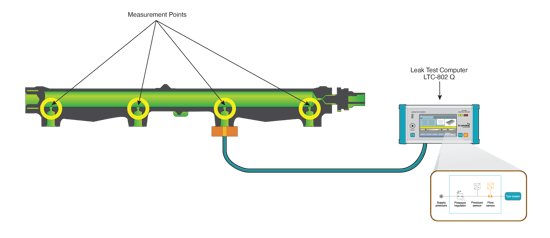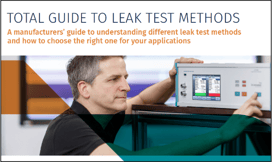Air leak testing is a common method used by manufacturers. It is a flexible test method that can be used to leak test a wide variety of parts and applications. Under the category of air leak testing are several specific methods, including:
- Pressure change method
- Pressure differential method
- Pressure increase method
- Closed component method (and volume determination variation)
- Mass flow method
- Flow measurement method
How each leak test method works impacts which methods are best for different applications. Selecting the right air leak testing method for your application includes identifying your required leak rate, maximum test pressure, maximum temperature differences likely to occur during test, and desired cycle time. Part design and environmental factors can also impact the accuracy of your pressure measurement. You need to carefully consider these factors to identify which leak test method is right for your application.
Overview of air leak test methods and how they work
There are cases when more than one leak test method would work for your testing application. Deciding which is best to choose would come down to factors such as desired cycle time and budget. Learn more about each method below.
1. Pressure change method
This method could be right for you if:
- You are testing small volume parts
- You are testing to larger leak rates (> 1 cm³/min)
- You need a simple, cost-effective leak tester
This method could be wrong for you if:
- You are testing a flexible part
- You are testing a heated (warm/hot) part
How it works:
Pressure change measurement by means of an absolute / relative pressure sensor is one of the simplest and most reliable leak test methods on the market, and by far the most widely used method in leak testing.
In this approach, the part being tested is exposed to either overpressure or a vacuum, and the pressure change is determined over time. This process involves utilizing two different types of sensors to determine the pressure change:
- Using absolute pressure measurement, the test pressure is assessed relative to an ideal vacuum (0 bar absolute).
- Using relative pressure measurement involves contrasting the test pressure within the item against the surrounding atmospheric pressure. If the test pressure exceeds the ambient pressure, it is termed positive pressure; conversely, if it falls below the ambient pressure, it is termed negative pressure / vacuum.
The outcome of the measurement can be conveyed as a change in pressure or as a leakage rate using varying units. Due to its uncomplicated design, high reliability, and healthy balance between cost and performance, the pressure change approach is particularly well-suited for situations involving small volumes and/or large leak rates.
2. Pressure differential method
This method could be right for you if:
- You are testing small volume parts that require fast test times
- You are testing high test pressures
- You are testing flexible parts
- You need a simple, cost-effective leak tester
This method could be wrong for you if:
- You are testing a heated (warm/hot) part
- You are testing a part that requires large pressure drops or burst tests
How it works:
The pressure differential method is a very popular method in leak testing. Using this method, pressure is applied to a reference volume in addition to the test part. The reference volume could be a small internal volume or a master test specimen, for example. After stabilization, the pressure change between these two volumes is measured by a highly sensitive pressure differential sensor.
An additional absolute or relative pressure sensor monitors only the pressure in the test specimen. This allows the test pressure to be adjusted either absolutely to the ideal vacuum or relative to the ambient pressure and checked for rough leakage.
High pressures can also be tested with very accurate measurement resolution and low leakage rates, since the pressure difference sensor is pressurized from both sides. Static test pressure thus plays almost no role in this test type.
Typical applications for this test method include cooling ducts, cooling hoses, electrical connectors, and membranes—those with small volumes that require fast test times.
3. Pressure increase method
This method could be right for you if:
- You are testing parts with high test pressure (up to 1,000 bar) and short test times
- You are testing small leak rates (as low as 0.1 cm3 / min possible)
This method could be wrong for you if:
- You do not want high mechanical effort (use of a volume-optimized test chamber/bell jar)
How it works:
The pressure increase method begins with the test specimen being pressurized and adjusted in absolute or relative terms to the ambient pressure. The measurement takes place within a measuring chamber (bell) located around the part under test. Any leakage in the test specimen leads to a pressure change within the chamber. This is then recorded and evaluated using a pressure transducer.
The measurement result can be output as a pressure change or as a leakage rate. The pressure increase leak test method can be a good alternative to trace gas methods, given the ability to test parts at very high pressures (up to 1,000 bar), with very short cycle times.
The pressure increase method is sometimes performed in combination with the pressure reduction method (e.g. oil cooler), and can also be used for valve seat tightness tests.
4. Closed component method
This method could be right for you if:
- You are testing closed/sealed components (such as waterproof consumer goods)
- You need a simple, cost-effective leak tester
This method could be wrong for you if:
- You need fast cycle times (relatively long test duration)
How it works:
The closed component, or dosing, method is used for completely closed components that cannot be exposed to test gas via an opening, e.g., watches, cell phones, control units, etc.
The completely closed test specimen is placed in a measuring chamber (bell) which is then closed. This measuring chamber is not directly pressurized with positive or negative pressure but is dosed via a previously evacuated or filled pre-volume.
The volume between the test specimen and the measuring chamber is known, so that a defined pressure ratio is expected. Any leakage in the test specimen changes this ratio and thus leads to a change in pressure, which is recorded and evaluated by means of a pressure transducer or pressure difference sensor.
The principle of the dosing method can also be integrated into other measuring methods in order to perform a volume determination, a component interrogation or an exact gas quantity determination.
The following standard measuring methods with the dosing principle are available:
- Closed component method with pressure change method DA
- Closed component method with pressure differential method DR
The volume determination method is a close variation to the above closed component (or dosing) method. In this variation, a known pre-volume is filled or evacuated with a known test pressure and then expanded inside the test specimen. The volume of the test specimen is determined by the resulting pressure. The principle of volume determination can also be integrated into other measurement methods.
5. Mass flow method
This method could be right for you if:
- You are testing large volume parts
- You are testing small leakage rates
- You need fast cycle time (sensor response time < 1 sec)
This method could be wrong for you if:
- You are testing closed/sealed parts
- You can’t test with a reference volume
How it works:
The mass flow test method is used to test parts with large volume. The mass flow method is characterized by the direct measurement of the result in cm³/min. This is calculated with the volume factor (ratio between test and reference volume) and output as leakage rate.
The flow measurement is usually measured using either thermal mass flow or laminar flow sensors. During the test, the test specimen and the reference volume are simultaneously filled with positive or negative pressure. After the stabilization phase, the flow direction and mass flow between the two volumes is determined.
Due to the high accuracy and the compensation of volume and temperature fluctuation, this test method is particularly suitable for large-volume components such as fuel tanks, battery housings, body parts, etc.
6. Flow measurement method
This method could be right for you if:
- You are testing parts with designated inside diameter or flow channel
- You are testing complex components with multiple openings
- You are testing large leakage rates
- You require fast cycle time (< 2 sec possible)
This method could be wrong for you if:
- You are testing closed/sealed parts
- You are looking for a more cost-effective leak tester (higher cost than other leak test methods)
- Contamination is likely in your test environment
How it works:
The flow method measures flow rates of air, nitrogen, etc. through the test specimen. Depending on the flow size, it can be a leak rate or a flow measurement of gases. Flow measurement is one of the fastest air leak test methods (cycle times < 2 sec possible). The flow-through method is used when a test part’s continuity must be checked for quality. This part cannot be “closed” (not completely sealed).
The flow measurement is performed using either a thermal mass flow or laminar flow element and must be taken close to the test specimen (outside the leak test unit). For larger flow rates (< 50 l/h), a Pitot tube is usually used for pressure measurement. A precision pressure regulator is used to adjust the pressure in the test specimen throughout the test so that the volume flow at the input of the test specimen can be measured. Since the measured value is evaluated directly by the sensor and output in a leakage rate, a stabilization phase is not required and the measurement can take place directly after filling, allowing for faster cycle times.
Alternatively, a flow measurement can also be carried out using the dynamic pressure method. In this case, it is not the flow rate that is measured, but the change in test pressure when the cross-section is tapered or widened. Dynamic pressure measurement identifies bottlenecks in the component caused by accumulating gas. This allows a production defect to be detected very quickly and effectively. Dynamic pressure tests are frequently used to determine partial closures (e.g. > 30%), particularly in the automotive sector.
Implementation of air leak test equipment
Once you’ve determined the appropriate test method, you’ll need to consider how to integrate it into your plant. Part sealing and tooling are additional factors that will affect the success of your leak test. innomatec’s experience and expertise cover all of these areas and we can help you get the results you need from your leak test.
Have questions? Not sure which method is right for you?
The innomatec team is here to help!


